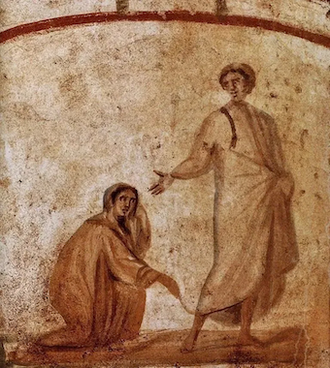Gospel in Art: All those who touched him were cured

A woman touching the cloak of Jesus, Catacombs of Marcellinus and Peter, Rome, 4th century AD © Christian Art
Source: Christian Art
Gospel of 5 February 2024
Mark 6:53-56
Having made the crossing, Jesus and his disciples came to land at Gennesaret and tied up. No sooner had they stepped out of the boat than people recognised him, and started hurrying all through the countryside and brought the sick on stretchers to wherever they heard he was.
And wherever he went, to village, or town, or farm, they laid down the sick in the open spaces, begging him to let them touch even the fringe of his cloak. And all those who touched him were cured.
Reflection on the Catacomb Mural Painting
One of the first Christian representations of Jesus ever, is this 4th century painting in the Catacombs of Marcellinus and Peter, Rome. It depicts the essence of the Gospel reading today: 'people were begging Him to let them touch even the fringe of his cloak. And all those who touched Him were cured'. It may also be the representation of Jesus healing the bleeding woman more specifically. Anyway, this shows how the early Christian communities were particularly taken with these Gospel readings telling us all about the healing powers of Jesus.
The ancient term to designate these burial sites is coemeterium (Latin for "cemetery"), which derives from the Greek (koimeterion = " resting place"). This etymological origin of 'resting place' indeed accentuates the fact that for us Christians, burial is just a final resting place, whilst we wait for the resurrection and be born into the new life.
The burial sites underneath the ground, were more specifically referred to as catacombs. The word catacomb again originates from the Greek language. It comes from the Greek words "kata," meaning "down," and "kymbas," which refers to a hollow or cavity. Indeed the bodies were buries into carved out hollow recesses deep underground.
We are well into Mark's Gospel now, at Chapter 6, and we can sense that we are at the height of the popularity of Jesus. People are desperate to meet Christ, see him and touch him. We hear that his healing powers are flowing abundantly for everyone, no matter who they are, where they come from or what illness they have. The crowds fully trusted in Him; just touching the cloak would heal them!
For us today, it is above all in the Eucharist that we touch the Lord and the Lord touches us. It is there above all that we bring our brokenness before him for his healing touch.
LINKS
Gospel in Art: https://christian.art/
Today's Reflection: https://christian.art/daily-gospel-reading/mark-6-53-56-2024/


















